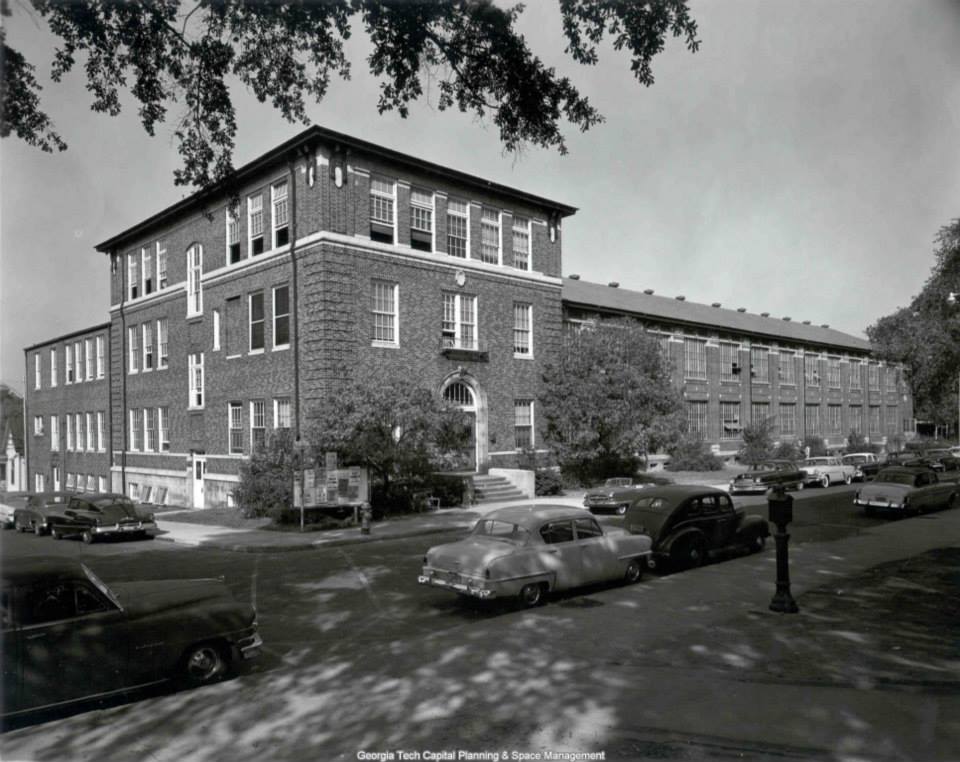Establishing the School - “The Little House Years”
Prior to 1959, although students enrolled in Georgia Tech were able to take courses in psychology, no official School of Psychology existed. However, based on the growing demand for an innovative psychology program that fit with the Institute’s scientific and technological model, the Board of Regents agreed to the formation of a School of Psychology at Georgia Tech.
Following the Board of Regents’ stipulation at the time that Georgia Tech could not have a program that was already represented at the University of Georgia, the original program, a B.S in Applied Psychology consisting of roughly around 200 quarter hours, was designed to be unique from any other existing psychology program in Georgia. In fact, it eventually served as a model for other psychology programs in the nation. Dr. Joseph Moore, one of the four original faculty members teaching psychology courses when the program was conceptualized, was selected as the School’s first Chair (then called School Director).
Candidates for the first undergraduate degree program underwent an extensive interview process by the faculty. The ten undergraduate students selected, all of whom had exposure to the physical sciences (physics, chemistry, etc.), remained a coherent class through their graduation date. Current School of Psychology Professor Emeritus, Dr. M. Jackson Marr, was a member of the very first undergraduate class.
1959-1995 – “The Skiles Years”
In 1959, Dr. Edward Loveland, the School’s second Chair and a major player in the establishment of the School, proudly accepted the honorary keys to the new classroom building in Skiles. At the time, teaching and research being conducted within the School was not only standard experimental psychology, but also industrial-organizational, engineering, and test design and administration. Original program majors were required to take courses in calculus, biostatistics, biology, comparative anatomy, engineering, and management.
During the early part of the Skiles years, the group of faculty was quite small and the entirety of their offices fit on the bottom floor of the building. Dr. Loveland would become a key contributor to the development of the School from a small department to a degree-granting School, offering first a Bachelor’s degree and then graduate degrees up through the doctoral level.
As early as 1978, Dr. Gregory Corso was among the group of faculty comprising the School during a time in which the number of students in an Intro Psychology section averaged just 40-50 students (as opposed to hundreds today). Dr. Corso would later serve as Interim Chair in the mid-1990’s, and again in 2010.
In 1967, Dr. Margaret Stephens Martin, who hailed from a family of prior Georgia Tech graduates, was the first woman to receive an undergraduate degree from the School of Psychology. She was also the first female to obtain a Master’s degree from the School in 1969.
In 1986, Dr. Anderson Smith, a Georgia Tech faculty member since 1970 (and currently Regents Professor in the School of Psychology), became the School’s third Chair. Serving as Chair until 1994, Dr. Smith initiated tremendous growth in the School, including the recruitment of several senior faculty. Dr. Smith also initiated a move to further expand the School’s experimental program.
1995-1997 – “The Textile-Hightower Years”
The School moved to a new location, the Textile-Hightower Building, in 1995. While the building conveniently included a large auditorium, faculty and students were often surprised by cats and dogs as a result of the ground floor doors being kept open. The open door design also resulted in winds whipping through the ground level, creating a wind tunnel effect, and it was not uncommon for faculty to find leaves outside their office doors.
That same year, Dr. Randall Engle was elected the School’s fourth Chair, where he served until 2008. Dr. Engle would lead the School through an era of abundant change that included the 2003 move to the School’s current home in the J.S. Coon Building.
1997-2003 - “The Naval Reserve Building Years”
In 1997, the School moved into an old naval reserve building, which was complete with a submarine simulator in the basement. Dr. Engle continued to negotiate for an improved facility that reflected the high quality and output of the teaching and research conducted within the School.
2003-Present – “The J.S. Coon Building Years”
2003 was marked by the School’s move into our present day location in the J.S. Coon Building. The historic J.S. Coon Building, which was built in five stages from 1912 through 1938 and initially housed the mechanical engineering department, underwent an extensive $9.1 million renovation prior to the School of Psychology moving in. While the interior of the building was modernized during the re-design, the building also retained many of the original characteristics.
In summer 2008, Dr. Fredda Blanchard-Fields became Interim Chair, and was officially elected the School’s fifth Chair in summer 2009. Dr. Blanchard-Fields lead an effort to document the School’s history in commemoration of its golden 50th anniversary, which culminated in a March 2010 celebration in Piedmont Park that was attended by over 160 students, current and former faculty, administrators, and alumni.
In January 2012, our current School Chair, Dr. Howard M. Weiss, was elected. Dr. Weiss was and remains committed to maintaining the exceptionally high quality of teaching and research programs conducted within our School, piloted by world-renowned faculty in the fields of Cognition and Brain Science, Cognitive Aging, Engineering, Industrial-Organizational Psychology, and Quantitative Psychology, as well as to fostering a School culture that emphasizes the importance of continually advancing the science of Psychology as a whole.
Today, the School of Psychology consists of twenty-four permanent faculty members. Our undergraduate student numbers have grown from 10 in 1959 to 180 majors and 170 minors in 2021. Further, our graduate student class is now close to 100. Based on the reputations of our impressive faculty, research programs, and graduates, these numbers are only expected to rise across the coming years.



